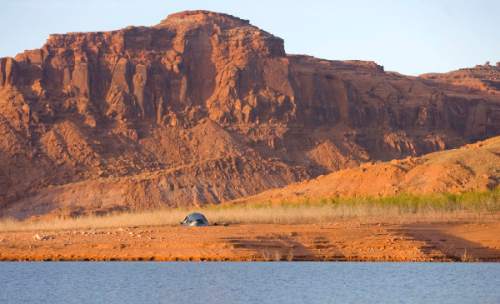This is an archived article that was published on sltrib.com in 2016, and information in the article may be outdated. It is provided only for personal research purposes and may not be reprinted.
Washington County water users could, theoretically, fund the construction of the Lake Powell Pipeline for as little as $25 per person per year, according to documents released Tuesday by the Washington County Water Conservancy District.
The water district has released two sets of slides and spreadsheets used in separate interactive presentations, one in November 2013 and another from February 2014, to explore how the water district might repay the debt that would be associated with the construction of the Lake Powell Pipeline. The district — which would receive 26.7 billion gallons of water a year from the proposed pipeline — was ordered to release the documents to the public last month by the State Records Committee.
The documents do not represent an official repayment strategy adopted by the district, said Karry Rathje, public information manager for the Washington County Water Conservancy District. Rather, she said, they were created and presented by the district's contractor, Applied Analysis, to allow focus groups to explore how the Lake Powell Pipeline debt might be repaid, depending on the circumstances surrounding its construction.
Participants in focus groups were able to input and change assumptions about population growth, the cost of the pipeline, the amount of water used by each Washington County household, and more.
The district decided to release the results of two focus group exercises, Rathje said, to demonstrate how changing those variables could greatly sway the cost of the pipeline for water users.
The November 2013 exercise — which assumed, among other things, a population growth rate of 2.9 percent and a 30 percent decrease in per capita water use — concluded that the construction of the Lake Powell Pipeline would cost Washington County water customers an average of $15.41 per month per household, with impact fees increasing to $4,062.61. The February 2014 exercise — which went with an average annual growth rate of 3.1 percent and a 33 percent decrease in per capita water use — came up with an average monthly cost of $6.28 per customer, with impact fees of $7,313.
Both exercises assumed the district could take out a loan for the project with an interest rate of 4.5 percent, and they assumed that the construction of the Lake Powell Pipeline would cost Washington County $969 million.
Rathje said that figure came from a 2008 estimate of construction costs, and she did not include the portion of costs that would be paid by the Kane County Water Conservancy District, which also may receive water from the pipeline project.
Under the Lake Powell Pipeline Development Act of 2006, Utah agreed to build the pipeline, but the project's beneficiaries must pay off the cost of construction within 50 years of the project's completion. More recent estimates have put the total cost of the Lake Powell Pipeline in the range of $1.3 billion to $2.8 billion.
Another analysis, completed last fall by economists from the University of Utah, found that the Washington County Water Conservancy District would have to raise impact fees by 123 percent, an average of $13,630 per connection, and raise water rates by 576 percent in order to afford the pipeline.
The water district said the U. report was wrong, and it told Utah media that it had its own repayment model that proved it was possible to finance the pipeline without such radical fee hikes.
But when the Utah Rivers Council, an opponent of the pipeline project, requested to see a copy of the district's repayment model via Utah's open-records law, the Washington Count Water Conservancy District denied the request, saying no such document existed.
The district's legal counsel continued to argue that it did not have a repayment model during a series of hearings before the State Records Committee, which ordered the release of the documents after the Utah Rivers Council appealed the water district's decision.
The district chose to release the financial surveys, Rathje said, rather than appeal the committee's decision, because the hearings process had clarified exactly what the Utah Rivers Council sought when it had requested a copy of a repayment model — which, she stressed, these documents are not.
"What [the Utah Rivers Council] requested, the district does not have, so we denied the request, because we didn't have one," she said. "Once we understood what they wanted, we complied with the request. It wasn't that we were fighting it, it's that we what they requested was different than what they wanted."
The released documents include — for comparison, she said — slides from the U. economists' report that the district had updated with water-usage rates from 2013 and 2014, the time of the focus-group meetings.
Zach Frankel, executive director of the Utah Rivers Council, said he was glad to see the documents released, but that he would wait until a more thorough analysis is complete to comment on their specifics.
"The [U.] economists did a really good analysis in October, and before they had even seen it, proponents of the Lake Powell Pipeline rejected it," he said. "We did not want to meet that insult in kind."
Twitter: @EmaPen



